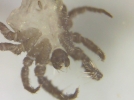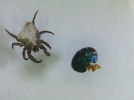
Invertebrates
See our handy guide to critters found in local homes and our Central Coast Butterfly FAQ. Browse the insects and other terrestrial arthropods we’ve identified. Check out local marine invertebrates, particularly bivalve mollusks and intertidal organisms.
- Anthropology
- Rocks & Fossils
- Invertebrates
- Vertebrates
- Botany
- Astronomy
- Fungi
- General
- Recently Asked
What is this horrible looking critter?
Was breaking apart some sandstone boulders to dig some very old marine fossils out of them and came across this very strange, very small insect, it's about maybe 1.5mm in size. Is this some sort of spider or something else? This looks like something that nightmares are made of, yikes!


Curator Response
Hi Ken,
The leggy critter appears to be a mite of the family Caeculidae, sometimes known as the rake-legged mites. Your photos show the undersurface, with the head end pointing down and to the right. Mites, a group which includes ticks, can generally be recognized by their small size (less than ¼ inch, and most non-ticks are way less), lack of antennae, single body segment and, at least in adults, the presence of eight legs. The latter feature reflects their inclusion in the arachnid group, to which spiders and scorpions also belong. Rake-legged mites are recognized by the large spine-like setae (hair-like organs on insects and arachnids) on the first pair of legs. Most of the setae are missing from this slightly damaged specimen, but the conspicuous cone-like bases of the setae remain. They use their spinose legs in their capacity as ambush predators of other tiny critters, generally lying in wait in the soil or among rocks in open, dry areas.
Like most mites not of veterinary, medical, or horticultural importance, they have been extremely poorly collected and studied, and we don’t even have a good idea of how many species are out there!
As for the greenish-blue metallic object, that’s head capsule of a bee or a wasp (possibly a cuckoo wasp, Chrysididae), complete with a pair of mandibles!
Stay curious,
Schlinger Foundation Chair and Curator of Entomology Matthew L. Gimmel, Ph.D.


